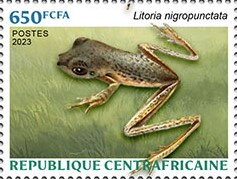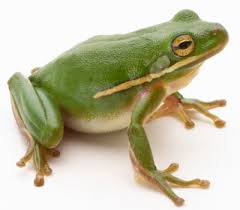Stamp: Black-dotted Tree Frog (Litoria nigropunctata) (Central African Republic 2023)
Black-dotted Tree Frog (Litoria nigropunctata) (Central African Republic 2023)
12 January (Central African Republic ) within release Frogs (2023) goes into circulation Stamp Black-dotted Tree Frog (Litoria nigropunctata) face value 650 Central African CFA franc
| Stamp Black-dotted Tree Frog (Litoria nigropunctata) in catalogues | |
|---|---|
| Yvert et Tellier: | Yt: CF 10230 |
Stamp is square format.
Also in the issue Frogs (2023):
- Mini Sheet - Frogs face value 6*650;
- Souvenir Sheet - Leptodactylus latrans face value 3,600;
- Stamp - Beautiful Narrow-mouthed Frog (Microhyla pulchra) face value 650;
- Stamp - Bella Vista Toad (Rhinella dorbignyi) face value 650;
- Stamp - Black-dotted Tree Frog (Litoria nigropunctata) face value 650;
- Stamp - Javan Chorus Frog (Microhyla achatina) face value 650;
- Stamp - Javan Horned Frog (Megophrys montana) face value 650;
- Stamp - Northern Leopard Frog (Lithobates pipiens) face value 650;
Stamp Black-dotted Tree Frog (Litoria nigropunctata) it reflects the thematic directions:
Amphibians are ectothermic, anamniotic, four-limbed vertebrate animals that constitute the class Amphibia. In its broadest sense, it is a paraphyletic group encompassing all tetrapods, excluding the amniotes (tetrapods with an amniotic membrane, such as modern reptiles, birds, and mammals). All extant (living) amphibians belong to the monophyletic subclass Lissamphibia, with three living orders: Anura (frogs), Urodela (salamanders), and Gymnophiona (caecilians). Evolved to be mostly semiaquatic, amphibians have adapted to inhabit a wide variety of habitats, with most species living in freshwater, wetland or terrestrial ecosystems (such as riparian woodland, fossorial and even arboreal habitats). Their life cycle typically starts out as aquatic larvae with gills known as tadpoles, but some species have developed behavioural adaptations to bypass this.
Animals are multicellular, eukaryotic organisms of the kingdom Animalia (also called Metazoa). All animals are motile, meaning they can move spontaneously and independently, at some point in their lives. Their body plan eventually becomes fixed as they develop, although some undergo a process of metamorphosis later on in their lives. All animals are heterotrophs: they must ingest other organisms or their products for sustenance.
A frog is any member of a diverse and largely carnivorous group of short-bodied, tailless amphibians composing the order Anura[(coming from the Ancient Greek ἀνούρα, literally 'without tail'). The oldest fossil "proto-frog" Triadobatrachus is known from the Early Triassic of Madagascar (250 million years ago), but molecular clock dating suggests their split from other amphibians may extend further back to the Permian, 265 million years ago. Frogs are widely distributed, ranging from the tropics to subarctic regions, but the greatest concentration of species diversity is in tropical rainforest. Frogs account for around 88% of extant amphibian species. They are also one of the five most diverse vertebrate orders. Warty frog species tend to be called toads, but the distinction between frogs and toads is informal, not from taxonomy or evolutionary history.
Reptiles are tetrapod (four-limbed vertebrate) animals in the class Reptilia, comprising today's turtles, crocodilians, snakes, amphisbaenians, lizards, tuatara, and their extinct relatives. The study of these traditional reptile orders, historically combined with that of modern amphibians, is called herpetology. Because some reptiles are more closely related to birds than they are to other reptiles (e.g., crocodiles are more closely related to birds than they are to lizards), the traditional groups of "reptiles" listed above do not together constitute a monophyletic grouping (or clade). For this reason, many modern scientists prefer to consider the birds part of Reptilia as well, thereby making Reptilia a monophyletic class.




